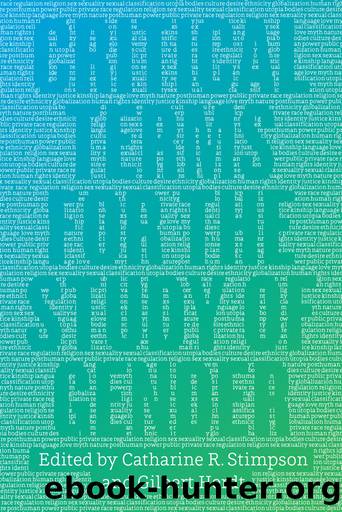Critical Terms for the Study of Gender by Catharine R. Stimpson Gilbert Herdt

Author:Catharine R. Stimpson, Gilbert Herdt [Catharine R. Stimpson, Gilbert Herdt]
Language: eng
Format: epub
ISBN: 9780226774817
Barnesnoble:
Goodreads: 18526738
Publisher: University of Chicago Press
Published: 2014-07-16T00:00:00+00:00
14 : : POSTHUMAN
RUTH A. MILLER
Stelarc walks the Posthumanist talk. William Gibson (2012)
Stelarc is a performance artist best known for swallowing, weaving, piercing, or otherwise introducing into his body mechanical, robotic, or bio-engineered parts. William Gibson is a science fiction writer best known for coining the term cyberspace in the early 1980s. Neither has a great deal to do with gender studies. But Gibsonâs comment on Stelarcâs art is nonetheless a comment on what the posthuman is doing in gender studies. The posthuman has altered both genderâs talk and genderâs walkâreconfiguring both the problem of gendered speech and the problem of the gendered body. Moreover, the posthuman has complicated one of the basic goals of gender-based activismânamely, the search for agency. And finally, the posthuman has raised the specter, or the promise, of a postgender, as well as posthuman, world. When Gibson comments on Stelarcâs walking talk, therefore, he is pointing to the radical rearticulation, if not the potential dissolution, of gender-conscious ways of thinking, doing, being, and living.
A History of the Posthuman
A neologism, the posthuman is an ambivalent term. It is ethically and politically up for grabsâand gender studies scholars have used it to express approval as well as uneasiness. For some, it represents a promising new approach to well-established problems in the study of gender. For others, the challenges it poses to the fieldâs conventions are politically paralyzing.
The termâs meaning and influence, however, have also changed over time. The posthuman, as a concept, came into common use at the end of the twentieth century, alongside futuristic, utopian scenarios in which, for instance, Gibsonâs (or misreadings of Gibsonâs) âcyberspaceâ would replace physical space and immortal, infinite, digitized minds would transcend mortal, finite, material bodies. In these technophilic fantasies, the virtual or digital posthuman was opposed, and superior, to the (merely) embodied human. Today, these late twentieth-century stories seem hopelessly dated. As much as they continue to lurk behind the term, they have little influence in posthuman studies of gender.
Instead, and perhaps unexpectedly, the posthuman has become a key concept in histories of gender. Neologism though it may be, the posthuman has been mobilized most effectively when gender studies scholars have searched for antecedents to ongoing rhetorics that link gendered existence to apparently nonhuman thingsâto machines, to nature, or to environmentsâto anything but the disembodied, virtual, or digital human intellect. The posthuman has been mobilized most effectively, in other words, when scholars have sought to explain why gendered existence has historically evoked nonhuman organic, mechanical, or environmental material.
As much as the virtual or the digital is present in the work that calls itself posthuman, then, it is the conceptâs invocation of physical matter that makes it relevant to gender studies today. After all, when Stelarc suspends himself from hooks embedded in his flesh as a posthuman statement, this performance is hardly virtual or disembodied. Nor is the posthuman as it operates in the field of gender studies. Indeed, there are distinct affinities between the scholarship that draws on posthuman analytic
Download
This site does not store any files on its server. We only index and link to content provided by other sites. Please contact the content providers to delete copyright contents if any and email us, we'll remove relevant links or contents immediately.
The Power of Myth by Joseph Campbell & Bill Moyers(1001)
Half Moon Bay by Jonathan Kellerman & Jesse Kellerman(952)
A Social History of the Media by Peter Burke & Peter Burke(935)
Inseparable by Emma Donoghue(921)
The Nets of Modernism: Henry James, Virginia Woolf, James Joyce, and Sigmund Freud by Maud Ellmann(833)
The Spike by Mark Humphries;(764)
The Complete Correspondence 1928-1940 by Theodor W. Adorno & Walter Benjamin(746)
A Theory of Narrative Drawing by Simon Grennan(742)
Culture by Terry Eagleton(712)
Ideology by Eagleton Terry;(696)
Bodies from the Library 3 by Tony Medawar(680)
Farnsworth's Classical English Rhetoric by Ward Farnsworth(673)
World Philology by(673)
Game of Thrones and Philosophy by William Irwin(669)
High Albania by M. Edith Durham(654)
Adam Smith by Jonathan Conlin(648)
A Reader’s Companion to J. D. Salinger’s The Catcher in the Rye by Peter Beidler(646)
Comic Genius: Portraits of Funny People by(616)
Monkey King by Wu Cheng'en(609)
